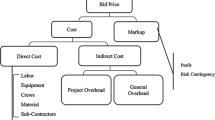Abstract
For construction policies to be effective and efficient, an integrated and systematic approach, with which the effectiveness of alternative policies can be examined in advance by anticipating the private sector’s response and subsequent changes in the industry environment is needed. As an effort to address this issue, a model-based approach is presented for construction policymaking and an example of a prefabrication policy in Singapore is given. In this study, the policy models developed using system dynamics simulate the performance of the Singapore construction industry and examine the effectiveness of alternative prefabrication policies in a qualitative and quantitative manner. Having obtained policy implications from the model structures and simulation results, policy initiatives are suggested along with discussions on the associated potential risks. Based on the research findings, we could conclude that a model-based approach is helpful in developing an effective construction policies by providing policymakers in a government or corporate with an integrated view on the policy application process and a tool to examine alternative policies in a systematic manner.
Similar content being viewed by others
References
Building and Construction Authority (BCA) (1994). Construction economic report, Government of Singapore, Singapore.
Construction Manpower Committee (CMC) (1999). Construction 21, Ministry of Manpower and Ministry of National Development, Government of Singapore, Singapore.
Cyert, R. and March, J. (1963). A behavioral theory of the firm, Prentice Hall, Englewood Cliffs, NJ.
Eisenhardt, K. and Zbaracki, M. (1992). “Strategic decision making.” Strategic Management Journal, Vol. 13, pp. 17–37.
Forrester, J. (1961). Industrial dynamics, Pegasus Communication, Waltham, MA.
Groak, S., Bottom, D., Gann, D., and Meikle, J. (1996). Innovations in Japanese prefabricated house building industries, Construction Industry Research and Information Association.
Ho, S. (2000). Impact of legislation of buildable designs and foreign labor policies on construction productivity, MS Thesis, Department of Building, National University of Singapore, Singapore.
Kwak, S. (1995). Policy analysis of hanford tank farm operations with system dynamics approach, PhD Thesis, Department of Nuclear Engineering, MIT, Cambridge, MA, pp. 34–36.
Lim, K. (1993). Prefabrication: Viability and future trends in singapore, MS Thesis, Department of Building, National University of Singapore, Singapore, p.59.
Lyneis, J., Cooper, K., and Els, S. (2001). “Strategic management of complex projects: A case study using system dynamics.” System Dynamics Review, John Wiley & Sons, Hoboken, NJ, Vol. 17, No. 3, pp. 237–260.
Moxnes, E. (2000). “Not only the tragedy of the commons: Misperceptions of feedback and policies for sustainable development.” System Dynamics Review, John Wiley & Sons, Hoboken, NJ, Vol. 16, No. 4, pp. 325–348.
Ritchie-Dunham, J. and Galvan, J. (1999). “Evaluating epidemic intervention policies with systems thinking: A case study of dengue fever in Mexico.” System Dynamics Review, John Wiley & Sons, Hoboken, NJ, Vol. 15, No. 2, pp. 119–135.
Royston, G. (1998). “Shifting the balance of health care into the 21st century.” European Journal of Operational Research, Vol. 105, pp. 267–276.
Slaughter, E. (1998). “Models of construction innovation.” Journal of Construction Engineering and Management, Reston, VA, Vol. 124, No. 3, pp. 226–231.
Sterman, J. (2000). Business dynamics: System thinking and modeling for a complex world, McGraw-Hill Companies, New York, NY. pp. 191–232.
Tan, S. (2000). Architects: The key to incorporating prefabrication into the construction process, MS Thesis, Department of Building, National University of Singapore, Singapore, p.157.
Tan, W. (1982). Prefabrication in housing: A study of fully industrialized building systems for housing and the singapore housing and development board’s attempt in this field, MS Thesis, Department of Building, National University of Singapore, Singapore, p.121.
VTT (2000). Wellbeing through construction in Finland, VTT Building Technology, Finland, available at Internet: <http://www.vtt.fi/rte/dms/pdf/wellb2000.pdf, Aug. 2003.>
Author information
Authors and Affiliations
Corresponding author
Rights and permissions
About this article
Cite this article
Park, M., Ingawale-Verma, Y., Kim, W. et al. Construction policymaking: With an example of singaporean government’s policy to diffuse prefabrication to private sector. KSCE J Civ Eng 15, 771–779 (2011). https://doi.org/10.1007/s12205-011-1243-4
Received:
Accepted:
Published:
Issue Date:
DOI: https://doi.org/10.1007/s12205-011-1243-4




